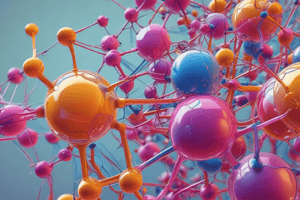Podcast
Questions and Answers
What is the main reason for the stability of aromatic compounds?
What is the main reason for the stability of aromatic compounds?
- The delocalization of π electrons (correct)
- The presence of conjugated double bonds
- The presence of a benzene ring
- The planarity of the ring
What is the characteristic of aromatic compounds that is responsible for their unique chemical properties?
What is the characteristic of aromatic compounds that is responsible for their unique chemical properties?
- Planarity
- Delocalization of π electrons (correct)
- Conjugation
- Stability
Which of the following is NOT a characteristic of aromatic compounds?
Which of the following is NOT a characteristic of aromatic compounds?
- Solubility in water (correct)
- Planarity
- Delocalization of π electrons
- Conjugation
What is Huckel's rule related to?
What is Huckel's rule related to?
Which type of aromaticity does azulene exhibit?
Which type of aromaticity does azulene exhibit?
Why are aromatic compounds common in biomolecules?
Why are aromatic compounds common in biomolecules?
What is an application of aromatic compounds?
What is an application of aromatic compounds?
What is the result of delocalization of π electrons in an aromatic ring?
What is the result of delocalization of π electrons in an aromatic ring?
Flashcards are hidden until you start studying
Study Notes
Aromaticity
Aromaticity is a property of conjugated planar rings that exhibit exceptional stability and unique chemical properties.
Definition
- Aromatic compounds are cyclic, planar, and conjugated molecules with a specific number of π electrons.
- Aromaticity is a result of the delocalization of π electrons in a ring, leading to increased stability and unique chemical properties.
Characteristics
- Planarity: Aromatic compounds are planar, meaning they lie in a single plane.
- Conjugation: Aromatic compounds have alternating double bonds (conjugated double bonds) in the ring.
- Delocalization: π electrons are delocalized, meaning they are not localized between two atoms but are distributed throughout the ring.
- Stability: Aromatic compounds are more stable than non-aromatic compounds due to the delocalization of π electrons.
Huckel's Rule
- Aromatic compounds follow Huckel's rule, which states that a planar, monocyclic ring with (4n + 2) π electrons is aromatic, where n is an integer.
- Examples of aromatic compounds that follow Huckel's rule include benzene (6 π electrons), naphthalene (10 π electrons), and anthracene (14 π electrons).
Types of Aromaticity
- Benzenoid aromaticity: Aromatic compounds that contain a benzene ring, such as benzene and naphthalene.
- Non-benzenoid aromaticity: Aromatic compounds that do not contain a benzene ring, such as azulene and fulvalene.
Importance of Aromaticity
- Aromatic compounds are common in biomolecules, such as amino acids and nucleic acids.
- Aromatic compounds are used in a wide range of applications, including pharmaceuticals, dyes, and plastics.
- Aromaticity plays a crucial role in the unique chemical properties of aromatic compounds, such as their reactivity and stability.
Aromaticity
- Aromatic compounds are a type of molecule that exhibit exceptional stability and unique chemical properties due to their conjugated planar ring structure.
Definition
- Aromatic compounds have a specific number of π electrons and are cyclic, planar, and conjugated molecules.
Characteristics
- Aromatic compounds are planar, meaning they lie in a single plane.
- They have alternating double bonds (conjugated double bonds) in the ring.
- π electrons are delocalized, meaning they are distributed throughout the ring, leading to increased stability.
- Aromatic compounds are more stable than non-aromatic compounds due to the delocalization of π electrons.
Huckel's Rule
- Aromatic compounds follow Huckel's rule, which states that a planar, monocyclic ring with (4n + 2) π electrons is aromatic, where n is an integer.
- Examples of aromatic compounds that follow Huckel's rule include benzene (6 π electrons), naphthalene (10 π electrons), and anthracene (14 π electrons).
Types of Aromaticity
- Benzenoid aromaticity: Aromatic compounds that contain a benzene ring, such as benzene and naphthalene.
- Non-benzenoid aromaticity: Aromatic compounds that do not contain a benzene ring, such as azulene and fulvalene.
Importance of Aromaticity
- Aromatic compounds are common in biomolecules, such as amino acids and nucleic acids.
- They are used in a wide range of applications, including pharmaceuticals, dyes, and plastics.
- Aromaticity plays a crucial role in the unique chemical properties of aromatic compounds, such as their reactivity and stability.
Studying That Suits You
Use AI to generate personalized quizzes and flashcards to suit your learning preferences.




